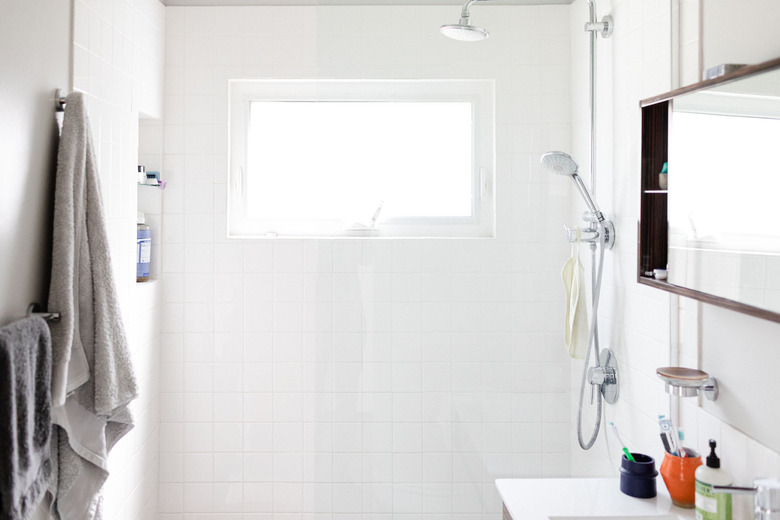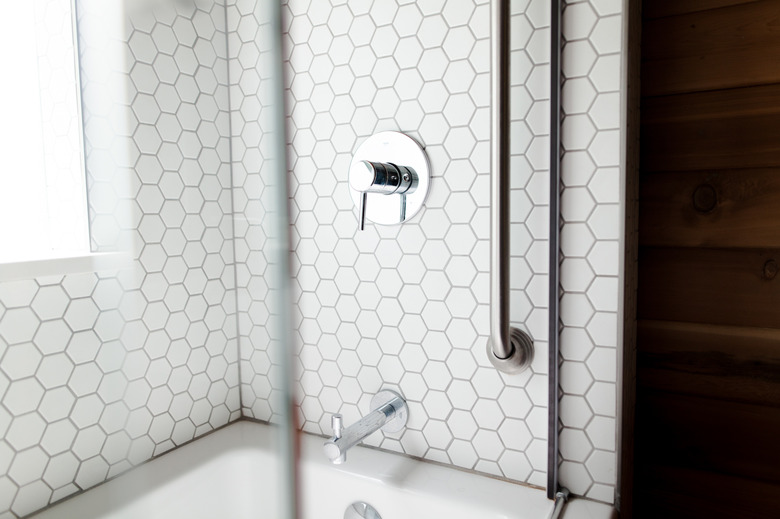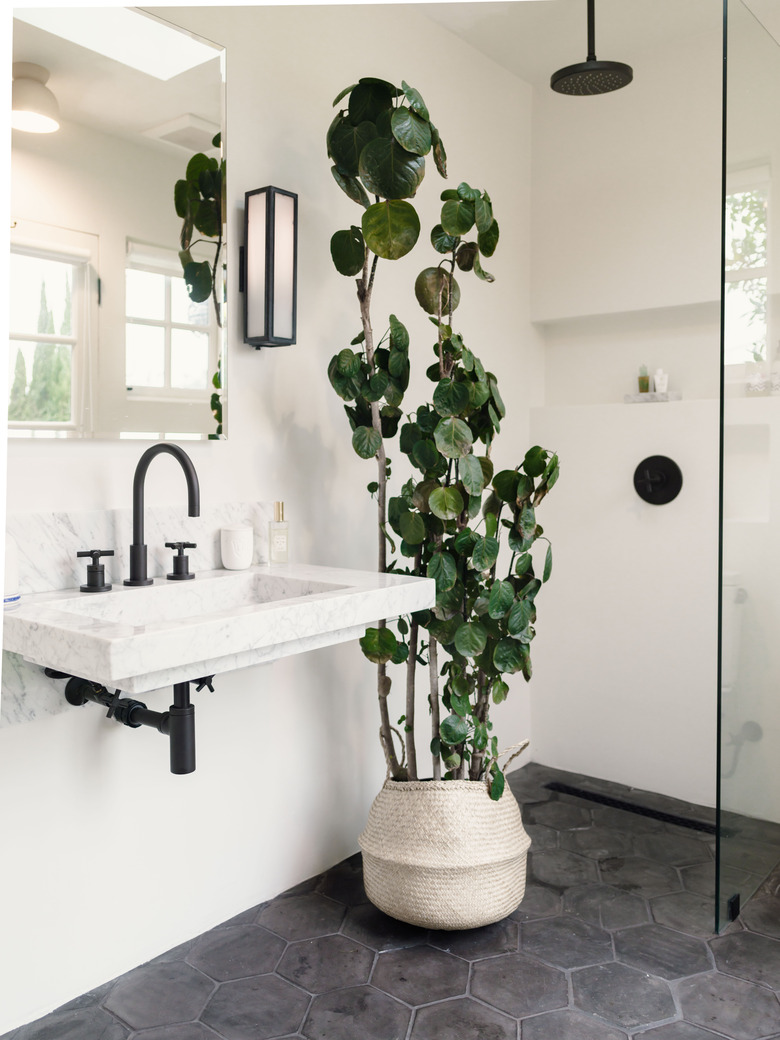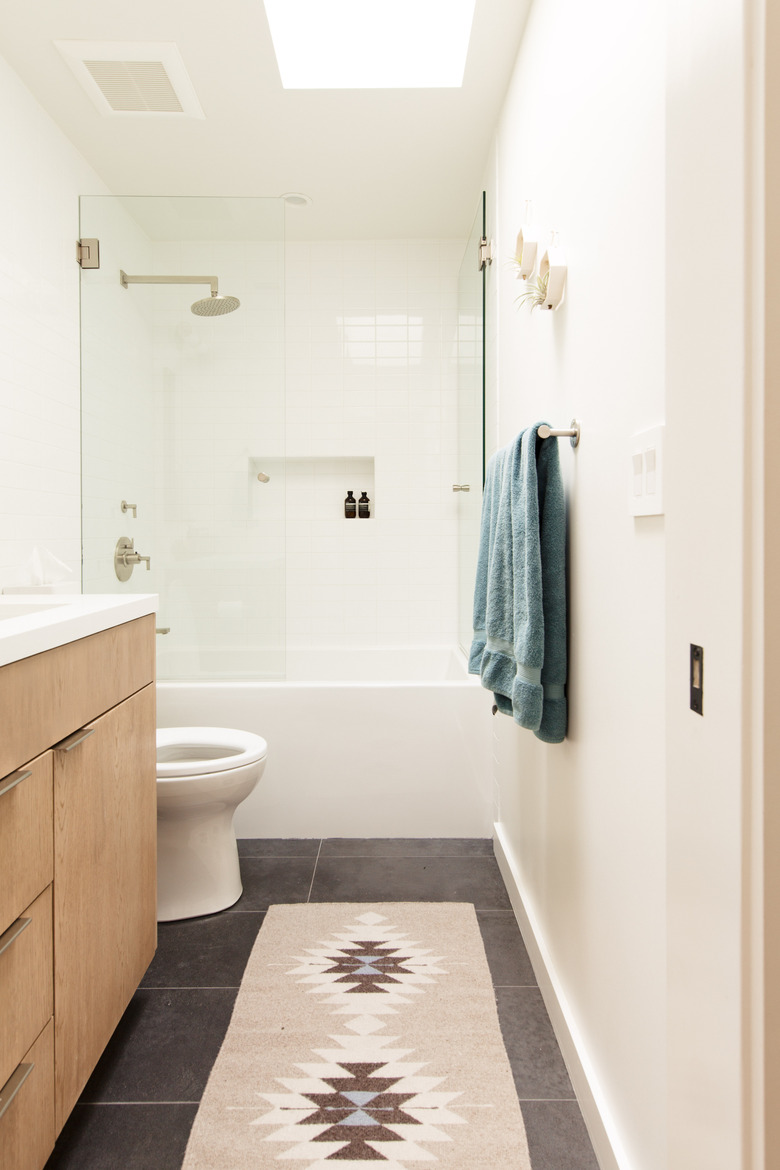A Homeowner's Guide To Shower Faucets
Many remodeling wish lists include installing a new shower or expanding one that is already there. A shower upgrade usually calls for choosing the faucet hardware that will make the water flow and complement the design of the new space, such as a shower-only faucet, a tub-shower combination or controls for an in-home spa.
As bathtubs have slowly faded and showers have become more and more ubiquitous, the faucets that control them have become more sophisticated and functional. Shower faucet systems can include a range of extras. You can find a shower-only faucet that controls water temperature, that serves as a speaker for your favorite tunes or that can be controlled from your smartphone, among other things.
Parts of a Faucet
Parts of a Faucet
Shower faucets as well as those used for bathtubs play a big part in the overall design of the room. Usually, they match or at least complement the other hardware in the room. That is why they are available in dozens of finishes and materials. In a shower, the faucet handles usually match the showerhead and are often sold with the showerhead as a set.
The faucet handles you see are only part of the faucet system. The handle is connected to a valve that is installed behind the wall. In the trade, the faucet handle, the showerhead or anything on the user side of the wall is called a "trim kit." It is the shower valve that does the yeoman's work of mixing the incoming hot and cold water to just the right temperature and diverting the flow of water to the showerhead, body sprays or whatever other accessory is part of the shower. Some valves are designed to maintain a preset water temperature and water pressure.
Shower faucets of all types need both the trim kit and the valve to work properly, and valves are an important part of installing or changing shower trim kits.
Shower Faucet Trim and Showerheads
Shower Faucet Trim and Showerheads
A shower-only faucet consists of faucet handles and a showerhead. In the past, all faucets had two handles: one for cold water and the other for hot. They are still available and are often used to complement traditional bathroom designs. The handles can be either knobs or levers, but people with limited mobility in their hands find levers easier to use. Single-handle faucets have become more popular than two-handle trim kits.
Showerheads come in a variety of sizes and shapes. A popular one right now is a large round or square head that is mounted overhead. It produces an experience that replicates standing in a rain shower. Most showerheads are adjustable so that they can provide different spray options. Even stationary showerheads can be manipulated to change the angle of the flow.
Some showerheads have built-in LED lights for those interested in chromatherapy, which provides a soothing experience while showering. Others have reservoirs for essential oils or some other medium for an aromatherapy experience. Do you want to hear your playlist while showering? There are showerheads with Bluetooth-enabled waterproof speakers.
Showering accounts for about 17 to 20 percent of residential water use. Typical showerheads use 2.5 gallons of water per minute (gpm). To reduce water use, the Environmental Protection Agency started the WaterSense program. To earn the WaterSense label, a showerhead can use no more than 2 gpm, but you can find products that use less. Good products can make 1.5 gpm feel like a much stronger flow.
Types of Shower Trim Kits
Types of Shower Trim Kits
In addition to shower-only faucets and trim kits, there are a variety of other types available. Each has specific uses and functions it can perform.
Tub and shower combination kits may be the most common trim kit used, especially in family bathrooms. They consist of single-handle or double-handle faucets that control both a showerhead and a tub filler. A diverter redirects the water flow from the tub filler to the showerhead. This type is often sold in sets, but each component can be purchased separately.
Handheld showers provide a certain degree of portability. A long hose brings the water stream to the person showering rather than the person having to go to the stream. They are great for bathing children and aiming the water directly where you want it.
Some handheld showers are mounted directly to the shower arm — the short pipe that protrudes from the wall. Others can be mounted to the wall with the hose attached to the shower arm. Combination units include a fixed showerhead as well as a handheld wand. A diverter switch directs the water to either section or to both at once.
Some showerheads are mounted on a vertical slide bar that allows you to move the showerhead up or down. These let you set the showerhead position to a height that is most comfortable for the person using it.
Shower Faucet Systems
Shower Faucet Systems
A shower system is a collection of components that are designed to provide a spa-like experience. The system can be prepackaged, or you can customize it with the components you want. A typical system might include multiple showerheads, such as a rain showerhead hanging from the ceiling and a pulsating head attached to the wall, a handheld showerhead, body sprays and a steam generator.
Other spa-like options include customized lighting or waterproof, Bluetooth-enabled speakers, such as Kohler's Soundtiles, and digital readouts of water temperature and water use. The U by Moen system lets you activate the shower with your voice. You can also control the shower and set the water temperature using a smartphone app. The system works with home assistants like Alexa, Siri and Google assistant.
Shower systems require extensive plumbing behind the wall. They make use of yards and yards of piping or hoses as well as multiple diverters to direct the water to the desired showerhead or spray.
A shower panel, also called a shower tower, is a type of self-contained shower system. It consists of a metal or glass frame that contains the showerheads, body sprays and controls on one side and the plumbing necessary to operate them on the other. Two hoses connect to the hot and cold water lines, and the panel hangs on the shower wall, concealing the plumbing. While installation is simpler than a behind-the-wall system, some demolition is necessary to access and modify the water lines.
Choosing a Faucet
Choosing a Faucet
Like selecting any other fixture, it's helpful to ask yourself a few questions when choosing faucets.
Where is the bathroom? If the shower is part of a master bath, you may want to consider an attractive set that comes with some luxurious touches, such as body sprays or a showerhead that provides a rain-like experience. For a family bathroom, a handheld shower may be more functional so that everyone in the family can use it easily.
Who will use the shower? Showerhead placement, handheld units or those whose height can be adjusted are ways to make the shower comfortable to use for a number of people of different heights. People with limited mobility who shower while sitting on a bench or shower chair will find handheld sprays useful.
What do you expect from a shower? Sure, everyone wants to get clean, but do you need a showerhead that massages sore muscles or one that provides different types of spray? Do you want to be able to listen to music or the morning news while showering?
What's your budget? As with most products for a bathroom remodel, there is a wide range of prices from which to choose. You can find simple faucets and showerhead trim kits for around $100, or you can go for the tricked-out shower system that includes multiple spray heads, body sprays, special lighting and Bluetooth compatibility for over $1,000. Installation of complicated systems can double the cost.
Installing New Showerheads
Installing New Showerheads
One way to change the look and functionality of the shower is to install a new showerhead. You can find replacement showerheads at home centers and plumbing supply stores. The fittings are standard, so most showerheads will adapt easily to the existing shower arm, which is the short pipe that protrudes from the wall. You can make the change using a set of tongue-and-groove pliers, a small towel and some plumbers' tape.
Use the pliers to disconnect the existing showerhead. Protect the finish by placing the towel or some other piece of cloth between the nut and the pliers. Hold the shower arm steady with your free hand so that the arm does not twist. You may need another set of pliers or a wrench to hold the arm steady. Be sure to protect the finish with a towel or cloth.
To install the new showerhead, place a little plumbers' tape on the threads of the shower arm. Screw the new showerhead to the arm, being sure to protect the finish. Again, you may need to hold the arm steady.
Installing New Shower Faucets
Installing New Shower Faucets
It is not as simple to switch out faucet handles as it is to install a new showerhead. Each faucet manufacturer uses its own valves, and usually, they are not compatible with the faucets from another manufacturer. If the valve and faucet don't match, changing the trim kit means removing the wall finish to install a new valve. Even if the project involves gutting the room down to the studs, switching valves involves cutting out the old one and soldering the new one in place.
One solution is to use a universal trim kit. Actually, they are not universal because they don't work with all types of valves, but they do expand the universe of what is possible. The universal kit from Pfister works with Pfister as well as Delta and Moen valves. The Speakman neo universal trim kit works with Kohler, Moen, Delta and Symmons valves. These kits work with specific valves and not necessarily all valves used by the manufacturers.
The process involves removing the existing trim kit. Most are held in place by a setscrew that you remove with an Allen wrench, or they have a pry-off cap. You match the existing valve with drawings that come with the kit. Then, follow the instructions for replacing the faucet. These kits cannot convert a two-handle faucet to a single-handle model.
Cleaning Shower Faucets
Cleaning Shower Faucets
When you purchase a trim kit, it will usually include instructions for keeping it clean. Be sure to follow them because damage to the finish due to improper cleaning will void the warranty. Usually, wiping with a soft cloth and a mild detergent is all that is necessary.
Areas with hard water that contains minerals like calcium, lime, magnesium and the like can leave behind mineral deposits when the water dries. These are unsightly, and they can clog showerheads.
You may be able to use a cloth soaked in white vinegar to remove the deposits. An old toothbrush and vinegar may also work. For stubborn deposits, fill a gallon-size plastic bag about halfway with vinegar and attach it to the showerhead using rubber bands. Keep it in place for an hour or two and rinse with clean water.



